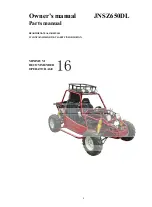
26
SECTION 7
MAINTENANCE INFORMATION
8. Start up and drive the vehicle for 10 minutes. Stop the
engine and check that the parking brake caliper has not
been dragging. A strong ‘brake material’ smell and a very
hot brake disk would indicate that the parking brake
caliper is adjusted too tight. Readjust if necessary.
7.4 HYDRAULIC BRAKE
7.4.1 GENERAL
Although the hydraulic brake system is self adjusting, the
following require periodic attention:
7.4.2 BRAKE FLUID LEVEL
After every 50 hours of operation, check the brake fluid level
through the side mounted view window in the master cylin-
der (Figure 7-15). The fluid level must be above the top of
the view window.
If the brake fluid is below this level:
1. Thoroughly clean the master cylinder cover and surround-
ing area.
2. Remove the two screws, lift off the cover and the gasket.
3. Add only fresh clean SILICONE - DOT 5 BRAKE
FLUID (Part No. 126-19) to the correct level.
4. Replace the cover on the master cylinder, making sure
the rubber gasket is properly seated before tightening the
cover screws.
Figure 7-15. Hydraulic brake cylinder and fluid level.
Do not overfill the brake master cylinders. Fluid level
must be at the top of the view window. Overfilling can
cause seal damage.
Use only SILICONE - DOT5 BRAKE FLUID. Other
brake fluid may not be compatible with brake compo-
nents and operating temperatures. Use of other fluids
will void the warranty.
7.4.3 CHANGING BRAKE FLUID
The inherent stability of Silicone DOT 5 Brake Fluid reduces
the need for frequent brake fluid replacement. Inspect the fluid
for degradation (discolouration or particles) during normal
fluid level inspections. If discolouration has occurred, the
brake fluid system should be drained, flushed and re-filled
with fresh brake fluid. If particles are evident in the fluid,
drain the system, overhaul the master cylinder and the brake
caliper before flushing and refilling. A CENTAUR dealer will
perform these operations for you.
7.4.4 HYDRAULIC BRAKE PAD INSPECTION
Inspect the brake pads after every 150 hours of operation.
Worn, glazed or contaminated brake pads affect the efficiency
of the brake system.
Brake Pad Inspection Procedure
With the engine cover removed, the hydraulic brake caliper
is visible. The caliper has 2 brake pads which are secured by
cotter pins (Figure 7-16). Inspect both brake pads. Replace
the pads when:
•
the brake lining material molded to each metal backing
plate is worn to 0.10" thickness. (Figure 7-17)
•
the pads are glazed and brake performance is affected.
•
the pads are contaminated with lubricant, and brake per-
formance is affected.
To replace the brake pads:
Remove both cotter pins from the brake caliper. Remove the
brake caliper from the transmission using a hex driver to re-
move the two SHCS mounting bolts accessible through the
brake disc hole as shown in Figure 7-16. Without disturbing
the connection of the brake line, swing the caliper away from
the brake disc to allow the removal of the brake pads. Install
the brake pads into the caliper assembly. Insert two new cot-
ter pins and bend the ends over to secure the pads in position.
Remount the caliper to the transmission, using #242 Loctite
Summary of Contents for Centaur V2001DT
Page 5: ...NOTES III...
Page 6: ...NOTES IV...
















































